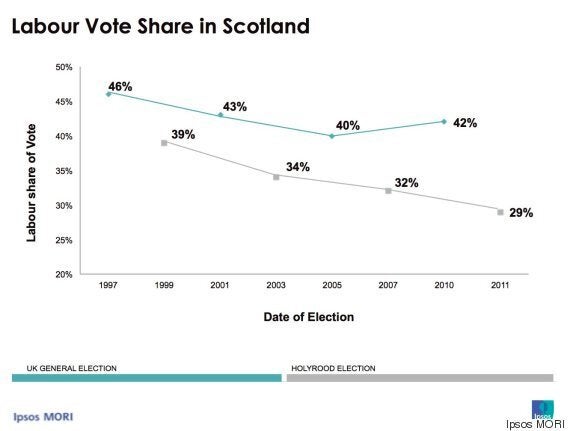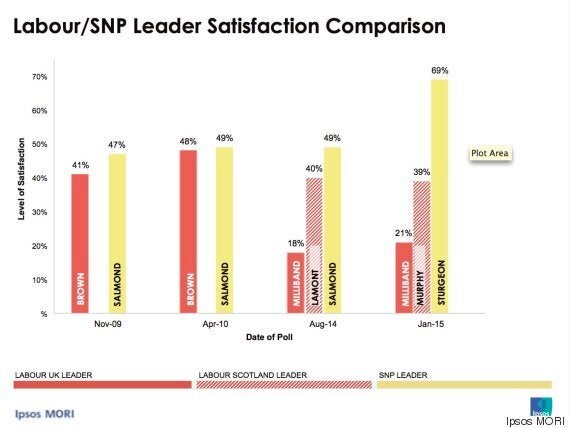Despite being on the winning side, last year's referendum has done few favours for the Labour Party in Scotland. But the origins of the party's decline and the parallel rise of the SNP go back much further than September 2014. And the impact could have profound effects across the UK.
For much of last year, the constitutional choice faced by voters in Scotland dominated politics across the UK. But if you thought the No vote in September's referendum would signal the return to business as usual, it is now clear that you may well be wrong.
Much has been written since our poll last October, the first conducted in Scotland since the referendum, indicated that the SNP might make sweeping gains, including in Labour's traditional urban heartlands.
The poll was treated with some caution; we were in an immediate post-referendum climate of uncertainty; Scottish Labour had recently lost its leader who had been critical of the party on her departure; general elections are traditionally seen as a contest between Labour and the Conservatives. All these factors surely meant that, as we got closer to May 7, we would see some support return from the SNP to Labour.
So far, no such movement is evident. As our polls and others have indicated, Labour has made few inroads yet on the SNP lead. This means that the SNP could have significantly more MPs than now and potentially more than Labour will have in Scotland after May 7. And in a tight contest in the race for No. 10, this matters not just for Scots but, possibly, for the make-up and direction of the UK government in the next five years.
In the last few months there has been much speculation about the referendum's impact on this shift of public opinion in Scotland. The SNP paint Scottish Labour as 'Red Tories' for campaigning on the same side as part of the 'Better Together' movement, arguing that they are the only party that can stand up for Scots' interests in a failing Westminster system.
However, while the referendum has undoubtedly crystallised and possibly accelerated Labour's decline north of the border, the origins of that decline go back much further than September 2014, and relate to issues wider than the constitutional question.
Firstly, the scale of the problem; since the first Holyrood election of 1999 the proportion of Scots voting Labour has declined, from 39% to 29% in 2011. The party has of course been out of power in Edinburgh since 2007. Further, the proportion of Scots voting Labour in general elections fell from 46% in Tony Blair's 1997 landslide to 40% in 2005.

Only in 2010, with Gordon Brown as Prime Minister, did the Scottish Labour vote briefly revive, up by two-points from 2005 to 42%. And it is the issue of leadership that provides the first clue to the change in party fortunes. Our analysis of the 2011 SNP landslide showed that the public was significantly more satisfied with then SNP leader Alex Salmond than any of his leadership opponents. And polling since 2011 enhances this trend, with first Salmond and now Nicola Sturgeon enjoying unprecedented levels of popularity, while the leaders of the other parties struggle for any significant traction among voters.
More specifically, for prospects in May, the current UK Labour leader has an approval rating among Scots below that even of Prime Minister David Cameron, and certainly well below the 48% satisfaction rating that Brown enjoyed immediately before the 2010 vote.

The second clue lies in policies and government popularity. Over recent years the SNP has put forward a policy programme which both resonates with voters and has left Scottish Labour struggling to differentiate itself. Research on options for public spending we conducted in 2010 identified that 78% of Scots supported a freeze on Council Tax rates, while 68% supported prioritising spending on the NHS over other public services; both measures were backed by significant majorities of Labour voters and both were central planks in the SNP's 2011 manifesto.
Add to this the continued high levels of public satisfaction in the SNP-led Scottish Government, often running at more than double the rating achieved by the UK Government among voters across Britain, and it is not difficult to see why opinion in Scotland appears to have shifted so dramatically over recent years.
So, yes the referendum appears to have changed the mood and the dynamic ahead of the general election; of course, if one party manages to capture the vast majority of the 45% who backed independence last year then they have a significant advantage in an election where the remaining 55% will primarily be split among the three other main parties.
Of course not a single vote has yet been cast. Such are the size of the majorities in many Labour-held seats that even a minor revival may prevent the complete meltdown that many currently predict. But it is clear that, for the second year running, Scotland may be at the epi-centre of the country's biggest political event.
Mark Diffley is Research Director for Ipsos MORI Scotland